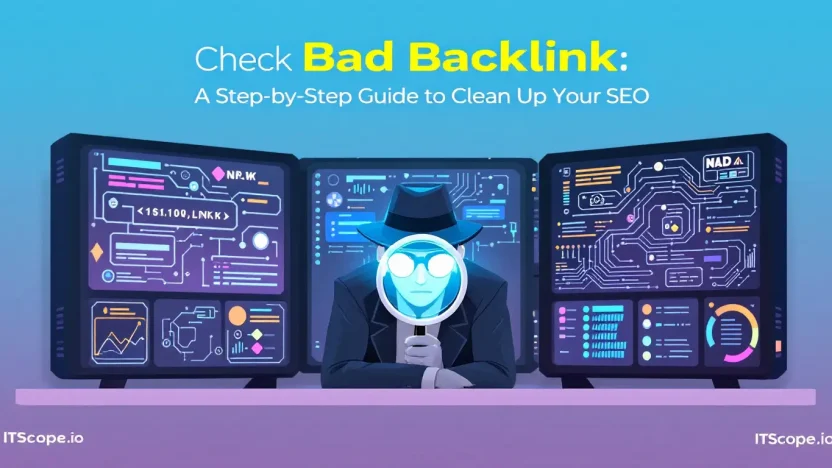Ever felt like your SEO efforts are getting bogged down by invisible anchors pulling your site rankings into the abyss? It’s time to dive deep into the murky waters of the web with our ultimate Check Bad Backlink guide. Bad backlinks can be like kryptonite for your SEO strategy, siphoning away your website’s potential to climb the SERP heights. But fear not, whether you’re a seasoned digital marketer or an IT professional itching to polish your SEO prowess, this guide provides a lifeline.
Stay on board as we unravel the mysteries of bad backlinks, guide you step-by-step through the identification process, and empower you with actionable strategies to detoxify your site’s link profile.
Table of Contents
- What Are Bad Backlinks?
- The Impact of Bad Backlinks on SEO
- Tools for Identifying Bad Backlinks
- Step-by-Step Guide to Check Bad Backlinks
- Strategies for Cleaning Up Your Backlink Profile
- Case Study: Rebounding from Bad Backlinks
- FAQs
- Conclusion
What Are Bad Backlinks?
In the world of SEO, not all backlinks are created equal. What defines a bad backlink? Simply put, bad backlinks are those that harm your site’s reputation and search ranking. Typically, these links come from spammy, irrelevant, or low-quality websites and can drag your site’s SEO down.
Why care about bad backlinks? Because Google and other search engines use links to determine the quality and relevance of your site. Here’s the kicker: if they’re coming from toxic sources, they could lead to penalties that tank your rankings! Therefore, it’s crucial to check bad backlinks regularly to maintain a healthy link profile.
Types of Bad Backlinks
- Spammy Links: Often generated by link farms or bots; they lack relevance and hurt your SEO.
- Irrelevant Links: Coming from websites unrelated to your niche, reducing your site’s authority.
- Low-Quality Links: Links from sites with poor content quality or excessively low domain authority.
Using a toxic links checker can help identify these destructive links. Identifying and removing toxic backlinks is essential for optimizing your SEO performance.
How to Identify Bad Backlinks
- Employ a toxic backlink checker tool to scan your profile. Popular tools include Ahrefs and others.
- Review the sources: Look at the domain authority and relevancy of linking sites.
- Check link context: Ensure that the content surrounding the link relates to your niche or industry.
- Assess for spam indicators: Watch out for links placed within spammy content or irrelevant anchor text.
Realizing the threat of bad backlinks is the first step towards protecting your site’s SEO health. For a deeper understanding, read about how toxic backlinks can impact your SEO rankings.
Key benefit of using a toxic links checker: It aids in quickly identifying harmful backlinks, safeguarding your website’s ranking integrity.
Remember, a solid backlink strategy is part of a successful SEO campaign. To learn more about the best tools and techniques, explore our comprehensive SEO tools guide.
The Impact of Bad Backlinks on SEO
Ever wondered how bad backlinks could derail your SEO efforts? Let’s dive into why addressing these toxic links is crucial. Bad backlinks can significantly harm your website’s search engine rankings, dragging down your site’s reputation faster than your least favorite top-40 song!
To put it simply, a bad backlink is an incoming link from a low-quality or spammy website that fails to follow ethical linking practices. These toxic links often come from irrelevant or dodgy domains that can make search engines view your site with a skeptical eye. By addressing and removing them, you safeguard your site’s credibility and online authority.
How Bad Backlinks Affect SEO
- Reduced Search Rankings: Search engines are smart—they recognize manipulative link practices. Falling for these can push your site down in search results.
- Decreased Trust from Search Engines: A cluster of toxic backlinks signals to search engines that your site might be untrustworthy, potentially leading to penalties.
- Wasted Crawling Budget: Search engines have limited bandwidth for visiting pages. Bad backlinks can misdirect this effort, skipping your quality pages.
- Hindered User Experience: Visitors might end up on irrelevant or harmful sites, leading to higher bounce rates and lower engagement.
By using a toxic backlink checker or a toxic links checker, you can identify and take action against these harmful backlinks. Check out our comprehensive guide on the best SEO tools to keep your link profile pristine.
Pro tip: Regularly check bad backlink concerns to uphold your site’s health and search performance.
Learn how to audit and resolve bad backlink issues with guides like this one to keep your SEO efforts sparkling clean and effective!
Tools for Identifying Bad Backlinks
Detecting and addressing harmful backlinks is crucial for maintaining a robust SEO profile. But how do you actually perform a check bad backlink analysis effectively? Let’s explore some top-notch tools designed to simplify this task. Whether you’re a seasoned SEO expert or a tech enthusiast keen on optimizing your site’s performance, these tools will guide you in weeding out toxic links.
- Ahrefs Backlink Checker: Known for its extensive database, Ahrefs helps in performing a thorough check bad backlink. It’s an excellent tool for identifying toxic links, providing detailed reports on your site’s backlink profile. Learn more about Ahrefs.
- WebCEO: This user-friendly tool offers a toxic links checker feature, highlighting potentially harmful backlinks that could affect your SEO. Explore WebCEO’s capabilities.
- Google Search Console: A free tool from Google that assists in tracking your site’s backlinks and spotting any irregular patterns. It’s a great starting point for any toxic backlink checker efforts.
- Securities by Moz: Moz’s comprehensive toolset includes capabilities to check bad backlink and safeguard your domain’s authority.
Need more tools? Check out our guide for the Best SEO Tools: The Ultimate Comprehensive Guide for Tech Enthusiasts.
By utilizing these tools, you can efficiently manage and enhance your site’s SEO, ensuring a healthy backlink profile. Interested in further insights? Visit this in-depth guide to toxic backlinks for a deeper understanding.
Step-by-Step Guide to Check Bad Backlinks
Struggling with SEO rankings? Checking for bad backlinks is crucial. In this guide, we’ll walk you through how to check bad backlinks using trusted methods and tools. Higher quality backlinks mean a better SEO profile, so let’s dive in and start cleaning up your links.
-
Identify Your Backlink Portfolio
Begin by accessing a comprehensive list of your website’s backlinks. Use a reliable tool like Ahrefs’ Backlink Checker to gather this data quickly. This step allows you to see all the linking domains, necessary for determining which might be harmful.
-
Analyze Each Backlink
Once you have your list, it’s time to scrutinize these backlinks. Look for signs of spam, irrelevant content, or low domain authority. Tools like WebCEO’s Unnatural Links Detection can help identify these toxic links.
Did you know? Toxic backlinks can seriously damage your site’s SEO performance, leading to penalties from search engines.
-
Use a Toxic Backlink Checker
Tools such as Hike SEO’s Toxic Backlinks Checker provide insights into harmful links that might be harming your SEO. These tools save time by highlighting links with harmful effects.
-
Remove or Disavow Bad Backlinks
Once you’ve identified suspicious backlinks, reach out to the site owners to request removal. If removal isn’t possible, use Google’s Disavow Tool to prevent these links from affecting your site. Find in-depth guidance in our Best SEO Tools Guide for this process.
Pro Tip: Regularly check bad backlinks, as part of your ongoing SEO maintenance, to maintain optimal health of your website’s profile.
-
Monitor Your Backlink Profile
Finally, make ongoing monitoring a habit. Use tools that alert you to new or potentially harmful backlinks quickly. This proactive approach ensures better site health and SEO success over time.
By following these steps, you can check bad backlinks effectively, ensuring your website remains healthy and competitive in the ever-evolving digital landscape. Always be vigilant about your backlink profile. Discover more tools and tips to enhance your site’s performance.
Strategies for Cleaning Up Your Backlink Profile
Wondering how to check bad backlink effectively and clean up your SEO profile? You’re not alone. A robust backlink profile is essential for your site’s health, and toxic links can severely damage your rankings. In this guide, we’ll show you how to identify and remove those pesky toxic backlinks.
Step 1: Identify Bad Backlinks
Start by conducting a thorough analysis using a toxic links checker. These tools help identify harmful links contributing to a negative SEO impact. Utilizing a toxic backlink checker allows for precise detection, saving you time and effort.
Step 2: Evaluate Link Quality
Focus on links from authoritative sites while scrutinizing ones that seem low quality or irrelevant. If a link doesn’t seem quite right, it most likely isn’t. Comparing your findings against lists provided by reverent SEO resources like Hike SEO can also streamline this evaluation process.
Step 3: Remove or Disavow Bad Links
Reach out to webmasters and request link removals for those identified as harmful. If removal isn’t feasible, use Google’s Disavow Tool to formally discount unwanted backlinks from affecting your SEO ranking. Regularly check your link profile to ensure it stays clean.
Maintaining healthy backlinks can boost your site’s SEO performance, making regular checks vital.
Useful Tools for Monitoring
Incorporate SEO tools like those listed in our Ultimate Comprehensive Guide for Tech Enthusiasts to enhance your link-checking strategies. Regular monitoring prevents the reoccurrence of toxic links, enabling consistent SEO improvements.
- Ahrefs: Excellent for comprehensive backlink analysis.
- WebCEO: Perfect for monitoring and removal requests.
- Google Disavow Tool: Crucial for handling stubborn toxic links.
Set Regular Checks
Make it a habit to check bad backlink profiles monthly as part of your SEO strategy. Staying proactive transforms potential problems into opportunities for growth.
Remember, keeping an eye on your backlink profile is not a one-time task. Regular checks ensure your hard-earned SEO performance remains unscathed by harmful links aimed to disrupt your success. After all, isn’t prevention the best cure?
Case Study: Rebounding from Bad Backlinks
Have you ever faced the daunting challenge of toxic links dragging down your site’s performance? One business found itself in this predicament, with rankings plummeting despite their quality content. Let’s explore how they managed to check bad backlinks and bounce back with a strategic recovery plan.
- Identify the Problem: The first step was using a toxic backlink checker to pinpoint harmful links affecting their site.
- Analyze and Prioritize: By evaluating the data, they distinguished between minor and major offenders. Focusing on high-impact links, they developed a tailored approach.
Remember, a systematic approach is crucial when dealing with backlinks.
- Take Action: They reached out to webmasters and disavowed persistent toxic ties using tools outlined in our Ultimate Comprehensive Guide for Tech Enthusiasts.
Implementing these steps helped reclaim their lost rankings, reinforcing the impact of a robust toxic links checker strategy.
FAQs
What is a bad backlink?
A bad backlink is an incoming link from a low-quality or spammy website that can harm your website’s SEO. Over time, these links might lead to penalties from search engines.
How do I use a toxic backlink checker?
To use a toxic backlink checker, enter your website’s URL in the tool. It will scan your backlinks and identify those that may be deemed as toxic or harmful. For detailed tools, visit Ahrefs Backlink Checker.
How can I check bad backlinks?
You can check bad backlinks using a variety of online tools like the WebCEO Unnatural Links Detection, which helps identify harmful links that might be affecting your site’s ranking negatively.
Will removing toxic links improve SEO?
Yes, removing toxic links can significantly improve your SEO by cleansing your backlink profile. This helps to prevent penalties from search engines and improve your site’s credibility.
What is the best tool for checking backlinks?
The best tools for checking backlinks include comprehensive SEO platforms like Ahrefs and SEMrush. For a more in-depth review, you can check out our Best SEO Tools Guide for Tech Enthusiasts.
For more strategies on managing your SEO, explore how to handle toxic links by visiting HikeSEO’s Guide to Toxic Backlinks.
Conclusion
Cleaning up your SEO is crucial in the digital age, where bad backlinks can negatively impact your site’s reputation and rankings. By using a toxic backlink checker, you can effortlessly check bad backlink profiles and ensure your link ecosystem remains healthy. Following our step-by-step guide to identify and disavow harmful links, your SEO strategies align optimally with search engine updates.
Taking immediate action when a toxic links checker flags suspicious sites is essential. By using advanced tools, you not only safeguard your site but also improve its chances of ranking higher on search engines. Remember, the more precise your efforts in managing backlinks, the healthier your overall SEO will become.
Explore our ultimate guide to the best SEO tools for more insights, and consider external resources such as WebCEO, Hike SEO, and Ahrefs Backlink Checker to enhance your link management skills further.
Gain peace of mind and elevate your SEO by consistently using a toxic backlink checker to monitor your backlinks.
Whether you’re a seasoned IT professional or a newcomer to SEO, these strategies empower you to maintain a pristine backlink profile, boosting your website’s authority and performance in the competitive online landscape.



